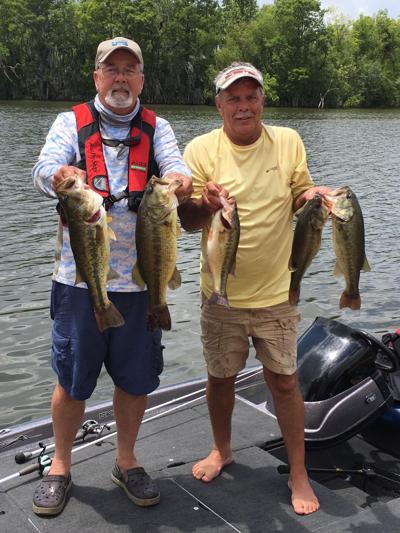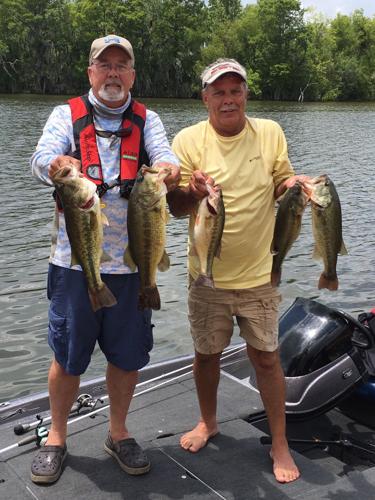If you want to know what’s going on in the Verret Basin, Steve Fontana and Chad Porto are the guys you want to question.
This Basin, separated from the massive Atchafalaya Basin by a many miles long levee, is pretty big, too. It’s a stretch of bayous, rivers, lakes and canals stretching from just south of White Castle south all the way to Morgan City and a couple of miles beyond.
Belle River, the Intracoastal Canal and lakes named, from north to south — Verret, Grassy and Palourde — are the biggest marks you’ll find on a map.
These days this area soaks up thousands of fishing hours. Bluegill and catfish are holding on the edges of the lakes, and there are enough bluegill and some sac-a-lait in the canals to hold panfishing interests.
That’s not what attracts Fontana nor Porto. They’re bass guys, and Fontana knows the Belle River/Intracoastal Canal about as well as anyone these days. Porto, while he’d never say it, is recognized by his peers as an expert on ol’ Mr. Largemouth in the big lakes, especially Verret.
With the Atchafalaya Basin high and still rising from spring floods and continued rains, it meant the guys competing in Saturday’s Bud Light bass tournament would find the going better on the "Verret side.”
And it’s no wonder Fontana, and his partner Brad Buoy, and Porto, fishing alone because partner Kevin Medine couldn’t make it, finished first and second with five-bass catches averaging more than three pounds per bass. Fontana and Buoy finished with 16.56 pounds, Porto with 15.16 and Willie and Warren Couch had 15.08 for the only three teams at three-pounds-per on a day when everybody on the water battled wind and dirty water.
“When we were sitting around waiting for the results, I asked Chad if he’d seen a shad spawn in the lake,” Fontana said. “I knew he was fishing the lake, and I was curious because I hadn’t seen the shad spawning in (Belle River).
“I had checked the water temperature in the river and it was 79 degrees (surface temperature), and we’ve had too much rain, and there’s so much flow in the river and into the Intracoastal that those areas were muddy,” Fontana said.
“I know we find the shad spawning when the water temperature hits 84 degrees and higher, and that’s when the bass get active, very active,” he said.
Fontana said Porto told him the shad were spawning in Lake Verret, that shad were ganging up around the (cypress) trees and roots and the bass were in there gorging on the shad.
“When that happens, it means you look for the white birds, the egrets and where you find the birds, you’re going to find the shad and you’re going to find bass. Birds and bass — both are feeding on the shad,” Fontana said. “And it (also) goes for (lakes) Verret, Grassy and Palourde.”
That’s only half the story. The action is fast and furious. It lasts for only a short period in the early morning.
“It’s a fact that the shad stay in the shallower water only until the sun gets over the trees and the sunlight hits the water,” Fontana said. “That’s true for Belle River and the lakes, and the guys who don’t make it early in the morning, well, they missed the big bite.
“When the sun hits the water, the shad move to deeper water, usually the first break they come to in deeper water and the bass will move with them,” Fontana said. “The bass have been eating in those first hours, and from what we’ve found, the bass lay under the shad and rise up to take a shad when they want to eat again. It’s a lot tougher fishing.”
Fontana said this is the time for baits resembling shad, small crankbaits, spinnerbaits, (Zara) Spooks and Chug Bugs, and for the guys who still have them in their tackle boxes, the old white Devil’s Horse, a topwater with spinners on front and back ends of the lure.
Fontana said while Porto was making his 15-plus-pounds in morning’s early light, he and Buoy were in the Stephensville area working over bass around clumps of hyacinths and grass, and their best five bass in the early morning, taken on Baby D-Bombs.
“It just seemed like we were grinding all day, like we weren’t catching anything. There was lots of boat traffic. We’d caught maybe seven or eight fish, and we knew we had a couple of 3-pounders, and that’s when I told Brad we needed to try fishing some deeper stuff, deeper water,” Fontana said.
That’s when he turns to his can’t-miss Belle River-Intracoastal bait, an old Bagley’s DB3, a deep-running crankbait — his favorite color is Tennessee shad — and works deeper, off-the-bank holes.
“With the water so muddy, it meant throwing chartreuse and black and I guess it was on the second cast that the big fish, that 4.5 pounder, hit the DB3,” Fontana said. “When I went back into the live well, I reached for the smallest fish. I had logged that fish in at two-and-a-half pounds and we were culling that for a fish two pounds heavier. That’s when I knew we had a chance to have a good stringer.”
Catching a “kicker” fish like that — it turned out to be the day’s heaviest bass — is always the key to a winning catch.
But Fontana didn’t leave it at that.
“I guess when the sun gets up, you can move to the outer (cypress) trees in the lake. The water is deeper there,” Fontana said. “Throwing those smaller, shad-colored baits in the early morning is going to mean you’re going to catch other fish. Gar are in there feeding on shad, too.
“And, the key to it all is when once the white birds are gone, the action is over in the shallow water next to the trees, and it’s time to look for something different, something in deeper water.”
The final regular-season Bud Light-South Louisiana tournament comes up June 10, and qualifying teams will move to the July 15 “classic.”
“That’s when my fishing gets good,” Fontana said. “The shad are up shallow early, then move out, and big crankbaits work on the bass.”


